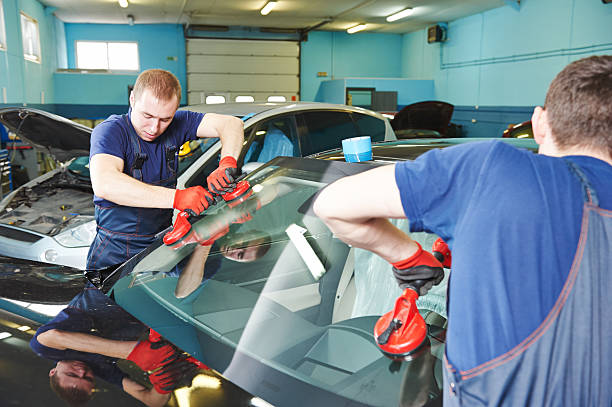Manhattan Beach’s Solution to Crystal Clear Views - One-Stop Solution For All Car Glass Repair!
Fill out the form below and we'll get back to you within 24 hours
Deciding between windshield replacement and repair is crucial for maintaining your vehicle's safety and functionality. A windshield is not just a piece of glass. It's a critical component of your car's structural integrity and safety system. Making the right choice depends on understanding the nature and severity of the damage, as well as considering factors like cost, time, and long-term safety implications. Understanding the basics of auto glass repair is pivotal in this process.
+1 (424) 352-0625This guide will help you navigate through the essential aspects of windshield damage assessment, the repair process, and when replacement becomes a necessity. By being informed, you can ensure your choice not only protects your wallet but also, more importantly, the safety of you and your passengers. Knowing when a small chip can be repaired or when a crack compromises the entire windshield is essential. This knowledge empowers vehicle owners to make decisions that uphold safety standards, ensuring that the windshield continues to offer the protection and visibility needed for safe driving.
Chips: Small, usually circular, damage caused by the impact of small objects
Cracks: Lines of damage that can vary in length, more serious than chips.
Shattered Glass: Extensive damage where the windshield is beyond repair.
Impact Location: Damage near the edges is more critical.

Size and Depth: Larger, deeper impacts typically require replacement.
Type of Glass: Different vehicles have varying glass strengths and qualities.
Understanding the type and extent of windshield damage is essential in determining whether repair or replacement is the best course of action. Early detection and assessment can save costs and ensure your safety on the road.
When faced with windshield damage, assess its severity to decide between repair and replacement. Consider the size and location of the damage. Generally, chips smaller than a quarter and cracks less than three inches long can be repaired. However, if the damage is in the driver’s line of sight or near the windshield's edges, replacement is often recommended for safety. Additionally, multiple cracks or a web-like pattern of damage usually necessitate a full replacement. Always consult with a professional technician to ensure an accurate assessment, as overlooking critical damage can compromise your vehicle's safety.
Step-by-Step Guide to Windshield Repair
Inspection: A technician evaluates the damage.
Cleaning: The damaged area is cleaned to remove debris.
Repair: A resin is injected into the chip or crack.
Curing: The resin is then cured with ultraviolet light.
Polishing: The area is polished for a clear finish.
Advantages of Repair Over Replacement
Cost: Repair is generally cheaper than replacement.
Time Efficiency: Takes less time, often under an hour.
Environmental Considerations: Less waste as the original glass is retained.
Choosing to repair your windshield service, when feasible, offers cost and time benefits and is an environmentally friendly option.
While windshield repair is advantageous, it has limitations. Benefits of windshield repair include cost-effectiveness, time efficiency, and environmental friendliness by extending the life of the existing windshield and preventing it from ending up in a landfill. However, repair is not suitable for large or complex cracks, especially those that extend to the edges of the windshield or those that obstruct the driver's view. Moreover, repairs on already compromised glass may not restore full structural integrity or clarity. In such cases, continuing to drive with a repaired windshield might pose safety risks, including impaired visibility and reduced protection in accidents. It's vital to understand these limitations and opt for replacement when necessary to maintain the highest safety standards.
There are specific scenarios where windshield replacement becomes inevitable for maintaining vehicle safety. Replacement is necessary when
severe damage occurs: Large, complex cracks or deep chips often can't be safely repaired.
Damage in Critical Areas: If the damage obstructs the driver's line of sight or is near the windshield's edges, where repairs might not hold.
Old or Multiple Damages: Older windshields with multiple repaired spots weaken over time, making them less reliable.
Safety should always be the priority. Windshield replacement ensures structural integrity and clear visibility, which are crucial for safe driving. When choosing to replace, opt for quality glass and professional installation to maintain your vehicle's safety standards.
Selecting the Right windshield replacement service is vital for ensuring quality and safety. Consider these factors:
Expertise and Certification: Choose technicians with proven expertise and necessary certifications.
Quality of Glass: Ensure the replacement glass meets OEM (Original Equipment Manufacturer) standards.
Warranty: Look for services offering a warranty on the glass and installation.
Customer Reviews: Check reviews to gauge service quality and customer satisfaction.
Proper installation is as crucial as the quality of the windshield. A reputable service provider not only offers high-quality glass but also ensures a secure and precise installation, which is crucial for your car's structural integrity and safety.
Phone : +1 (424) 352-0625
Website : https://www.southbayautoglassrepair.com/
Working Hours : Monday to Sunday 7 am - 9 pm